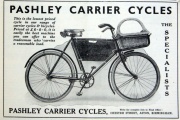
Pashley were motorcycles produced in Chester Street, Aston, Birmingham, from 1949 to 1953, and Carrier Cycles, by W. R. Pashley.
The firm introduced a three-wheeled commercial vehicle in late 1949. With three speeds and a 197cc Villiers engine, the rear part was based on a motorcycle and the front had twin independently sprung 8-inch wheels with an open truck body between them. It had a steering wheel and inter-connecting drum brakes. The whole of the rear section was enclosed by a steel bonnet on which went a pad for the driver. Four body types were listed.
By 1953 such vehicles had become dated and the firm turned its attention to a light three-wheeled car that never went into production.
...'The adaptation process obviously sparked some ideas in Pashley as, after the car, the company began making small motorised vehicles. The Pashley Pelican was a rickshaw-styled transporter of goods and people. This utilised Royal Enfield or BSA motorcycle front ends. The '3cwt Light Delivery Trucks', which used a Villiers 197cc motor, had the load carrying area at the front so that the driver could keep an eye on his goods. These vehicles, along with the standard carrier cycles, proved popular abroad with exports to Denmark and Holland in Europe, and South Africa and Argentina further afield. The Canadian Police made use of the motor rickshaw to collect money from parking meters...' [1]
See Also
Sources of Information
The British Motorcycle Directory - Over 1,100 Marques from 1888 - by Roy Bacon and Ken Hallworth. Pub: The Crowood Press 2004 ISBN 1 86126 674 X








